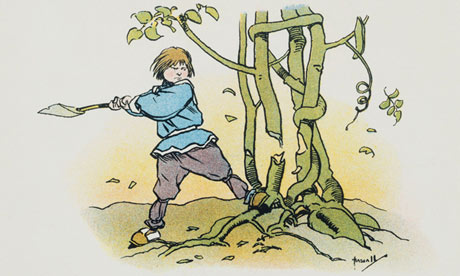Making e-readers more accessible is a great way of improving child literacy

A special edition of Jack and the Beanstalk is part of a new initiative to get kids reading. Photograph: Blue Lantern Studio/Corbis
A few weeks ago, Barnes & Noble, the American bookselling giant, announced it was ending manufacturing of its own tablet e-reader, the Nook, which has been on sale in the UK for a year now. While Nook made significant inroads into the US market, it hasn't sold as well over here, thanks to the established success of Kindle and Kobo. Moreover, there's a lot more competition from other device makers such as Samsung, Sony and Apple, all of which now include many ways to read books – including Nook software itself. However, Barnes & Noble has turned this into a bit of a win for readers, by offering huge inventory-clearing discounts on the Nook HD and HD+: top-spec readers reduced by up to £180 for the next few weeks.
Cleverly, it has also linked up with the Get London Reading campaign, avoiding accusations of a fire sale, and is donating 1,000 Nooks to London schoolchildren in the process. Each of the tablets comes preloaded with a special edition of Jack and the Beanstalk and Other Beany Stories, Poems and Jokes, a collection of new stories by children's authors and illustrators commissioned by literacy charity Beanstalk.
While 16,000 hard copies of the book are also being distributed, the spread of e-readers, particularly cheaper ones, is encouraging. A 2012 study by Scholastic in the US found children accustomed to screens more willing to read e-readers than paper books, a contested finding, but not one that should be dismissed either. At the moment, there's too much focus on high-end tablets, such as the iPad, which are only available to the children of wealthier parents. Initiatives such as those undertaken by Barnes & Noble and Beanstalk, or by Worldreader, which distributes Kindles preloaded with hundreds of books in sub‑Saharan Africa, go some way to reducing this gap.
Cleverly, it has also linked up with the Get London Reading campaign, avoiding accusations of a fire sale, and is donating 1,000 Nooks to London schoolchildren in the process. Each of the tablets comes preloaded with a special edition of Jack and the Beanstalk and Other Beany Stories, Poems and Jokes, a collection of new stories by children's authors and illustrators commissioned by literacy charity Beanstalk.
While 16,000 hard copies of the book are also being distributed, the spread of e-readers, particularly cheaper ones, is encouraging. A 2012 study by Scholastic in the US found children accustomed to screens more willing to read e-readers than paper books, a contested finding, but not one that should be dismissed either. At the moment, there's too much focus on high-end tablets, such as the iPad, which are only available to the children of wealthier parents. Initiatives such as those undertaken by Barnes & Noble and Beanstalk, or by Worldreader, which distributes Kindles preloaded with hundreds of books in sub‑Saharan Africa, go some way to reducing this gap.
No comments:
Post a Comment